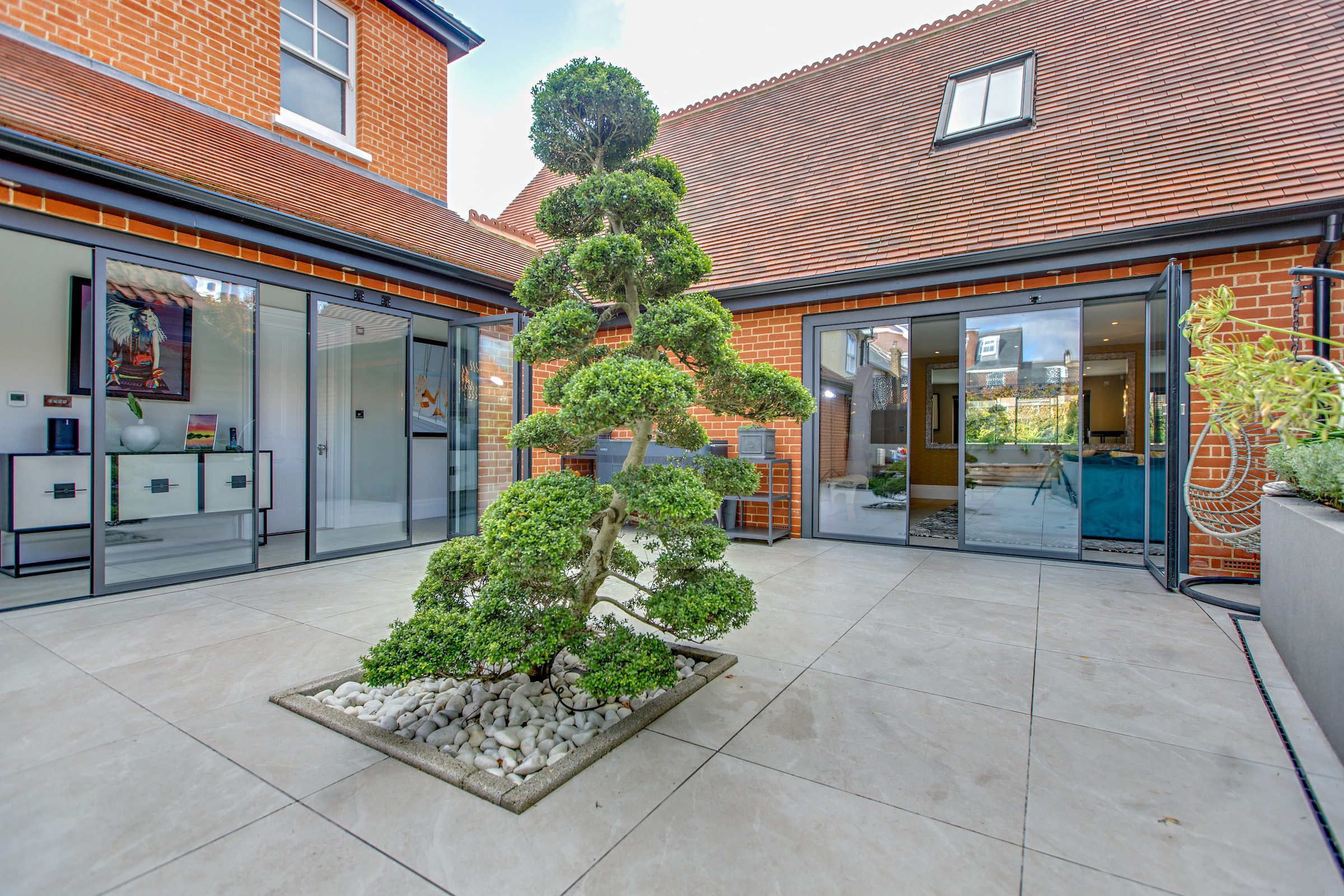There are several key features of slimline sliding doors making them different from regular patio sliders for the home. Whether you know them as ultra-slim sliding doors, panoramic sliding doors, minimal or frameless, we explain the critical features of slimline sliding doors and what to look for when researching or buying.

Why the key features of slimline sliding doors matter.
One of the reasons you’re probably considering patio door or glazing with a minimal look, is down to the impressive aesthetics these doors provide. Thinner than regular sliders and significantly thinner than folding sliding models, one of the important design features of slimline sliding doors is substantially more glass with reduced visible aluminium sightlines.
These sliding door types still slide in the same way as the familiar aluminium patio door, but won’t come with the more recent method of lift to slide. The inline design enables the doors to move within a single, double or triple track. The number of tracks is usually determined by the number of sliding panels and the door configuration.
When buying these types of sliding doors, you’ll always pay more. These doors in most cases cost more to make, more to transport and installation charges are higher too.

How the system matters on the slimline sliding doors you buy
One top tip in understanding the key features of slimline sliding doors is also knowing which ‘system’ you’re buying.
A substantial number of slimline sliding door brands use the Spanish Cortizo product and this can often be hard to spot. Many Cortizo doors are rebranded and only the trained eye spots you’re being quoted for exactly the same product but under a different name. So if you’re being marketed a slimline sliding door usually with a 20mm mullion and other similar features, chances are it’s the same door. You can get in touch with us with details of the brand and we can tell you whether this is Cortizo.
There’s absolutely nothing wrong with this brand and it remains one of the best sellers. If you’re happy with the price and your chosen installer, these doors, well made and fitted will serve you well. However, there are arguably better doors than Cortizo coming with better features of slimline sliding doors of this type. There are slimmer doors, those with a better method of installation, more flexible configurations and brands with better brand perception.
How to identify the six features of slimline sliding doors
The six significant differences between a conventional aluminium sliding patio door and slimline sliding doors are.
- Cost
- Aesthetics
- Operation
- Manufacturing
- Transportation
- Installation

How much do slimline sliding doors cost?
A standard sliding patio door from the main aluminium systems companies in the UK, fitted into a standard 3metre x 2500mm high can start from £3500. Slimline sliding doors at a similar size can start from £7500.00. As a result of the unexpectedly high cost, we receive many enquiries on this website asking for a more cost-effective solution that offers the same features and aesthetics. One solution is the SUNFLEX SVG30 with excellent sightlines of just 30mm at less cost.
If you are looking to fit one of the current generation slim sliding doors in your home, you should expect a high price although there are comparable products. Contact us for further information and advice.
Aesthetics.
The aesthetic advantage of slimline sliding doors is one of the main advantages. Every element of this kind of sliding door is thinner, less intrusive and maximising the glass area.
Slimline sliding doors are frequently seen in building openings that are taller and wider than a conventional door aperture. It is slimline doors that frequently have the aesthetics and sight lines to create a sliding glass wall. Some door products are possible at 5 metres high or more.
The interlock is the vertical mullion where the sliding panels meet. Many conventional sliding doors offer interlocks of between 35mm and 110mm. Slimline sliding doors are available with interlocks as narrow as 17mm. This significant reduction in one of the key structural and visual profiles of a sliding door is a big part of their appeal.
Operation.
Slimline sliding doors utilise the very latest rollers, gearing, components, locking systems and even motors. Many homeowners putting large and heavy doors in their home also take up the option to automate them. You will find most of the current slimline sliding doors on the market are available with an automatic opening and closing action.
Even when slimline sliding doors are manually operated, the gearing and rollers is so sophisticated they are effortless to open and close. Individual panels can weigh more than 400kg yet can be slid open with one hand.
Automatic operation is usually not available with conventional aluminium sliding doors.
Manufacturing.
Slimline sliding doors appeal because of their quality, high performance and top-end engineering. With the high cost of these doors, customers expect a flawless product. These doors must meet the exacting and demanding requirements of architects and discerning end-user clients and are manufactured to meet these demands.
Some products are manufactured around the glass; others are intended to be glazed once installed. Whichever method or product is used, the manufacturing methods in these types of doors differ from traditional sliding doors that are so simple to make some even come as cut to size kits.

Transportation
Slimline sliding doors are frequently much bigger than regular patio doors. Even the best and longest-established window and door installers only have standard size vans and will not own the equipment needed to transport the doors and handle the glass. Moving, glazing and installing slimline sliding doors often calls for specialist plant and machinery as well as trained installers. We would regard the installation of these doors as ‘high-end’ glazing.
The professional installers of slimline sliding doors should explain what is involved in delivering, fitting and glazing these doors. They are different to standard sliding doors.
Installation.
Precision manufacturing and flawless installation are paramount to ensure the reliability and long-term performance of slimline sliding doors.
Often the outer frame and track are hidden within the building structure to create a frameless and all-glass appearance. With the frames concealed, what happens should a sliding door require maintenance or repair? The professional installers of these doors have to consider all the scenarios post-installation and into the future.
Expect the installation of slimline sliding doors to be far more complicated and involved than with a conventional patio door. You can expect this to be reflected in the overall price as well.

Questions to ask before you buy slimline sliding doors
Chosen from the right manufacturer and installer, the features of slimline sliding doors such as those made by Cortizo, Sunvista, Reynaers, Origin and other brands all promise a standout slider with incredible styling and packed with appeal. But here are a few things to consider before you buy and the questions you need to ask of your installer.
How are products supported in the future?
The bonded slimline sliding doors are so new, that most are probably still under warranty and customers have right now the peace of mind of service and repair should there be a problem with their doors. For this reason, our advice is to buy these doors from reputable companies, demonstrating stability, reputation and preferably longevity.
The same applies to the company they source these doors from. Have these manufacturers been around long enough to give you confidence they’ll still be around in the unlikely event your doors need repair work?
What happens in the even of a glass breakage or failure?
With many of these doors made around the glass in a factory environment by trained people, it’s also worth asking the question of how is the glass replaced on the doors should it fail or break and especially when they’re out of warranty.
Non-bonded standard sliding doors are easy for any local competent glazier or repair company to change the glass even if out of warranty. If your particular product needs to go back to the factory, this could cause you problems in the future if your supplier has no interest in helping, no longer offers the product and, as it’s out of warranty, has little incentive you help you say, ten or more years later. Even Origin offering a 20-year manufacturer’s guarantee doesn’t cover the glass.
Remember, these doors are probably going to be outside the scope of local repair companies experts in the repair, adjustment and changing the glass in patio doors.
Summary
With so many features of slimline sliding doors as well as the many brands and types, it’s important to choose the product and the installer carefully.
- Always use an installer demonstrating expertise with slimline sliders
- Precise installation is everything with these products and diy/builder installation is not recommended
- Do your research in identifying which system you’re being offered or contact us for advice
- There are simpler sliding doors offering the similar sightlines, get in touch for more details
Above all, remember many of the images you see showing minimal frames all around are usually doors inset into the structure with the frame hidden from view and giving a more minimal look. The sightlines you get on the surround frame and track using a standard installation are usually thicker with most slim sliding doors.
A product marketed with 20mm sightlines usually refers to the mullions only and not the overall product sightline.










